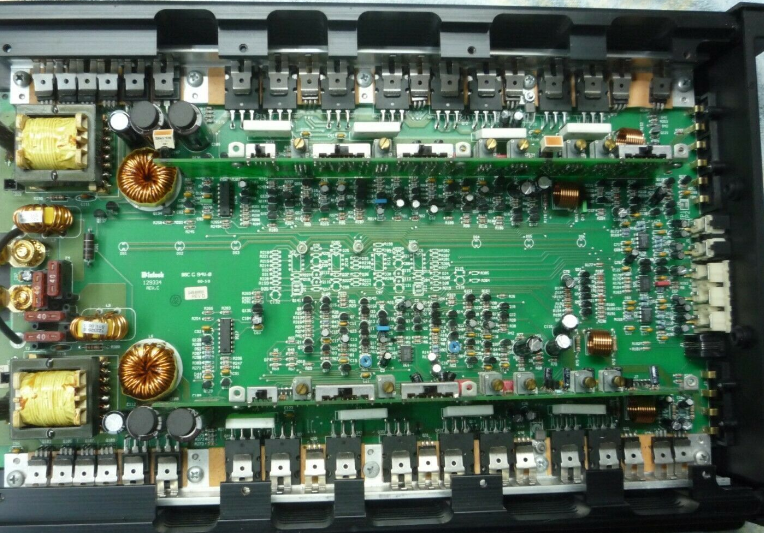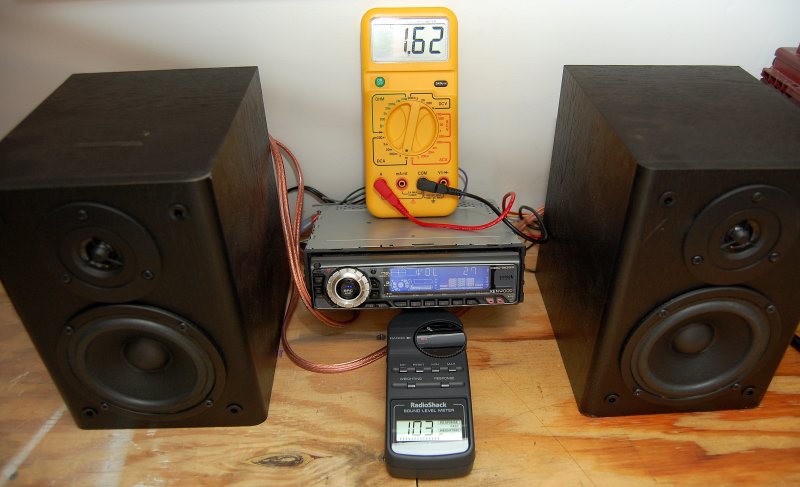Speaker wattage ratings are for the most part irrelevant and also very often bold faced lies. With clean power most any speaker out there, unless walkie talkie grade, can handle the "deck power" you are supplying it with.. When buying speakers focus on sound quality not what the package says in "W". When focusing on boat speakers focus on a brand that does not change the size or shape often. PolyPlaner speakers sound pretty poor but in ten years when your "new" speakers have been destroyed by UV and the manufacturer no longer makes them.... Well.....
I can guarantee I could blow up either of those speakers at far less than 100W, of real power, not bogus massaged & misleading marketing claims the car audio industry is wrought with. Most car decks can barely deliver 4-8 real watts per channel of power. My home stereo amp, only a two channel amp, no volume buttons, is rated at 100 WPC and it weighs over 80 pounds to do so. It has eaten 400W "rated" speakers for lunch. Did it to prove a point to a friend.. The speaker cones were popping at max extension at just 1/4 volume on my pre-amp. That was probably about 30 real watts against a 400W "rated" speaker.
The claims by many car audio companies are nothing but complete lies. As I mentioned above most of these decks are at best a 4-8 watt per channel unit at normal battery voltages. If you use any sort of "legitimate" wattage rating system.
This is what a 150 watt per channel amplifier would really look like. This amplifier weighs 90 pounds and requires its own dedicated 20A outlet on AC power..
This is what a "chip amp" looks like. They are found in most car in-dash stereos. it is about the size of a quarter and weighs about the same as a dime.
Car stereo ratings are most often heavily "massaged" numbers taking one specific easy to drive frequency, at a horrible THD distortion level, and rating a split second peak to trough. They have other sneaky ways of rating them too, like the "W" does not even mean watts but 400"W" or "WOW" factor and some other bogus shenanigans. These decks are more like 4-8 listenable WPC at best at 12.3 - 12.7V and perhaps up to 9-11W at 14.6V... Car audio companies are among the most misleading of any consumer brands when it comes to marketing claims, but they get away with it because the industry is rather lax, and only a few companies want to self regulate. Some manufacturers are more legit than others but the legit manufacturers lose out by being honest in a sea full of liars.
To be fair here is a 100 WPC car amplifier (at car audio "
quality"). This one only has somewhat misleading specs and rather decent sound quality. It will set you back about $2200.00... This amp is 3" Tall x 12.5" Wide x 18.4" Long. It will draw upwards of 30 - 50A DC when listening and 2.5A DC sitting there at idle doing nothing...
If you want a unit that is more fairly rated, still not a fool proof standard, buy one that says: "Amplifier Power Standard CEA-2006 Compliant." Keep in mind though that this power rating is at 1.0% THD and 14.4V. A 1.0% THD is HORRIBLE and in the ear bleeding range especially when you consider that it is not rated at 20 Hz to 20 kHz and they've picked a "favorable" frequency to rate it at. They are usually way worse than 1% THD if they were accurately rated from 20 Hz to 20 kHz.. My old amp was rated at 0.04% @ 20 Hz to 20 kHz.. This is in the range of not even audible across the entire frequency range but it took 90 pounds of weight and a dedicated 20A outlet to get there..
On a sailboat you're rarely at 14.4V, and 1% THD is a pretty poor level of distortion as far as sound "quality"... I would bet it is pretty hard finding ANY CAR OR MARINE DECK (not an external amplifier) that has a CEA-2006 "amplifier" rating. Manufacturers only tend to rate EXTERNAL AMPS not in-dash decks. They don't rate decks so they can lie to you in the aisles of Wal*Mart and Best Buy.
I found this a while ago and it makes for some interesting reading..
Outrageous Audio Claims
]http://www.outrageousaudio.com/page_files/amp_wattage.pdf]
You're just not going to find in-dash "deck power" in any car or marine stereo with a real 50WPC that meets CEA standards or any "reputable" method of testing output, but, you can find PLENTY of liars...Yes, you CAN find an external AMPLIFIER that puts out 50WPC but it will suck your battery bank like a Vampire sucks blood. A quick glance a the McIntosh amp above and its 30-50A DC current capability should solidify what it takes to produce a real 100WPC in a 12V amplifier. It really puts the "bogus" 240WPC in-dash car stereo in perspective..
From a typical car deck, such as a Kenwood Excelon, 0.5A - 1.0A renders a very "listenable" level but we have efficient speakers, two in the cockpit and two in the salon plus a sub..
This is two channels driven into 4 Ohm nominal speakers w/92 SPL "rated" efficiency. The voltage was 12.65V. A white noise CD was used and an SPL meter. The stereo is pulling 1.62A at 103 dB. 103 dB is very loud.
If we use Ohm's law we can see: 1.62A X 12.65V = 20.49W.. This stereo was sold as 200W or 50W per channel (4 channels). Between the input and the output there are also lots of efficiency losses to account for. At a nearly cranked volume, into two channels, it can barely pull 20.5W from the bank. This is why the real power is closer to 4 - 8 WPC or 4 - 11 WPC at 14.6V....
Bottom line stick with a manufacturer of speakers who does not change the sizes often. We've been through this with piles of customres and it gets expensive when the fancy & expensive speakers they purchased four years ago are now toasted by UV but there are zero replacemnets in that size/depth etc... Poly Planar wins in this category and they are
tolerable, more tolerable than drilling new holes every few years, at least in my opinion having been there and done that......





